Air heating: sources of heat energy
How can the air heating of industrial premises or a private house be organized? What can be a source of thermal energy? Which option is more profitable and more convenient to use? Let's try to answer these questions.
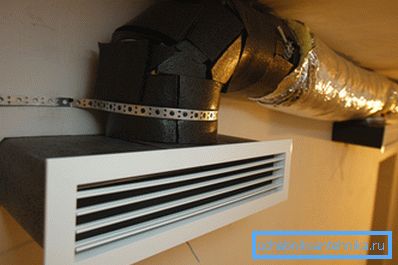
What it is
The answer to this question is simple and obvious. This scheme does not use intermediate heat carrier (water, steam, propylene glycol, oil, etc.). The equipment transfers heat directly to the air in the room; Often it is combined with the ventilation and provides not only heating, but also air exchange with the street.
Note: the calculation of air heating combined with ventilation is performed not by the heat capacity of the supply air, but by the level of heat loss from the room. For industrial premises, the need for heat is up to 100 W / m3; for residential - 40-60 W / m3.
Comparison with water heating
What are the disadvantages and advantages of air heating on the background of traditional systems with coolant?
pros
- From the chain of heat transfer from the source of thermal energy to the people and objects in the room, an extra link is excluded. Since the efficiency of any heat transfer is not equal to 100%, thus we get some savings.
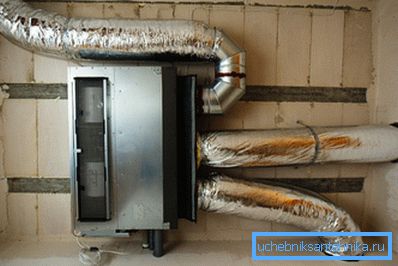
- Use as a coolant means that the room of an unused warehouse, workshop or garage can not be left without heating during the cold season.. Recovery of the thawed contour will cost a greater amount than the one that will be saved. The use of non-freezing coolants generally solves the problem; however, they themselves with a significant internal volume of the circuit will cost a fairly noticeable amount. Heat generators for air heating, in contrast, can stand idle at any temperature without any damage to themselves.
- Equipment for air heating can also work as a supply ventilation. Which, note, still have to be mounted in the production premises or a large cottage. Water heating is a separate item of expenditure.
- No additional measures are required to start air heating. (access to dumpboats for air bleeding, balancing with chokes, etc.).
In fairness: after balancing and the first run, properly designed water heating requires a minimum of attention. The automatic air heating valve installed instead of the Mayevsky valve will exhaust air without the participation of the owner.
Minuses
A serious flaw, perhaps, is only one. Installation of air heating is carried out mainly during construction or overhaul: the ducts and air distribution grilles are too large to be invisible.

In addition, the holes for air ducts in the internal partitions will be much larger than for pipes.
Heat sources
Let us turn to the consideration of methods of implementation, and above all - sources of heat. So, what is the air heating home, greenhouses or workshops?
Boilers
Gas boilers air heating differ from their counterparts for water systems only air heat exchanger and the presence of a fan. Other attributes are quite familiar: a closed burner with air extraction from the street through a coaxial pipe, electronic ignition control and a security system that stops the flow of gas when the flame is extinguished.
Solar boiler structurally very close to the gas. Moreover, many devices are able to switch from one type of fuel to another after a simple change of the burner.

Stoves, fireplaces
A variety of stoves and fireplaces, both originally designed for this purpose and modified by the owners, can serve as a source of hot air.
Please note: boilers for air heating are fundamentally different from a stove only in that they are not designed for direct heat transfer to a heated room through the walls of the housing.
What is usually the implementation of air heating from a solid-fuel stove or fireplace?
In short, several steel ducts of large cross section pass through the firebox or near it. The air heated in them can spread through the room due to natural convection or through the duct system.
Since warm air tends upward, and laying air ducts with a constant inclination is not always possible, stoves and fireplaces with air heating are often supplied with air forcing air into the heat exchanger channels by fans.
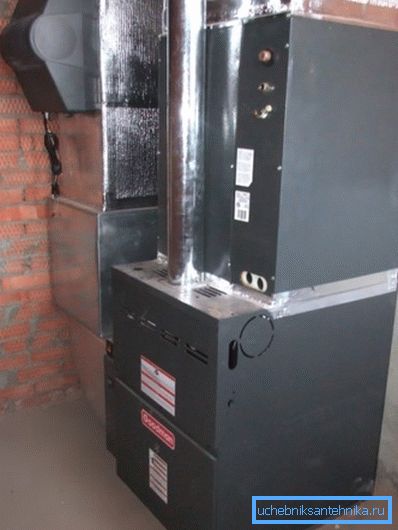
Tip: when arranging air heating with your own hands, the flow of air into the channels can be organized by conventional duct fans. To prevent plastic cases from melting during firing, a simple instruction will help: the fan is inserted not into the channel itself, but into the aluminum ventilation sleeve connected to it.
The most likely known solid-fuel stove for air heating is the so-called Buleryan. The name originally belonged to the developer of the design - the Canadian company of the same name; however, it has long become a household word.
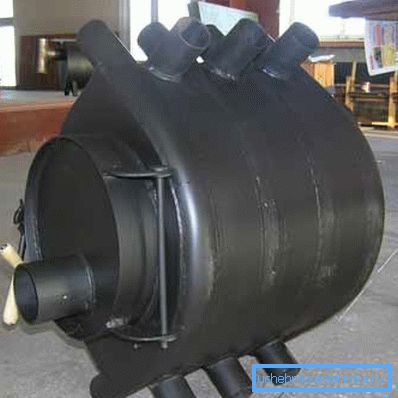
The furnace has two key features:
- Steel air ducts encircling the firebox are bent and crossed in such a way as to ensure the most efficient mixing of air in the room.
- Buleryan - pyrolysis oven. What does it mean? That the combustion of fuel is divided into two stages: the smoldering of firewood with a limited flow of air and the afterburning of products of incomplete combustion in a separate chamber.
Thus, the owner receives a number of bonuses:
- Long (up to 12 hours) work on one tab.
- Flexible adjustment of heat output without loss of efficiency. Products of incomplete combustion are not carried away into the chimney, and completely burned down in the furnace.
- No need for frequent cleaning of the firebox and ash pan. Coals in the process of pyrolysis does not remain in principle; A small amount of ash can be used to fertilize the backyard.
Electric Heaters
Fresh air is often heated by electric heaters, which are conventional tubular heaters (sometimes with finning, which increases heat transfer). The advantage of heating with electricity is that it does not require removal of products of combustion and any periodic maintenance.
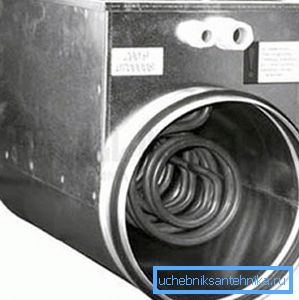
In addition, in this case, a simple and very flexible power control is available with the ability to connect remote thermostats, programmable remote controls, etc.
Only two drawbacks; but they are quite weighty.
- The required electric power for air heating is often tens of kilowatts. Not everywhere power lines allow you to get it.
- Heat obtained by direct heating with electricity is significantly more expensive than all alternatives. We give approximate values for current energy prices.
| Heat source | Price kilowatt-hour heat, rubles |
| Main gas | 0.7 |
| Firewood | 1.1 |
| Coal | 1,3 |
| Pellets | 1.5 |
| Liquefied gas (gas tank) | 1.8 |
| Liquefied gas (cylinders) | 2.8 |
| Solarium | 3.2 |
| Electricity | 3.6 |
Heat pumps
Finally, the most promising source of heat is heat pumps of various types. Among other things, they are interesting in that they provide not only heating, but also air conditioning.
How does such a device work?
- The refrigerant (freon) is compressed by the compressor and fed to the heat exchanger. Since during compression it, like any other substance, becomes very hot, an excess of heat is given through the radiator blown by the fan to the surrounding air.
- The freon which has given heat passes through the expansion valve and, being considerably increased in volume, cools. At the same time, he, passing through the second heat exchanger, takes through his excess heat from a low-potential source.
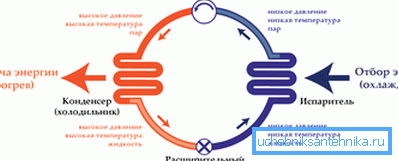
Different sources of heat pumps can use water, soil and air as a source of low-grade heat.
They attract two features:
- The heat pump can transport heat from a cold object to a warm one. For example, air heat pumps for heating Mitsubishi Zubadan can work on heating at an ambient temperature of -30C.
- It takes 3-5 times less energy to transport heat than direct heat. Thus, a kilowatt of heat energy costs the owner of the house not 3.6 rubles, but 0.8 - 1.2.
Each project of air heating by a heat pump (ground-air, water-air and air-air) has its own characteristics.
Ground air
The cost of the pump starts from about half a million rubles. Even at least the installation will cost the same amount: the heat exchanger probes are immersed in vertical wells up to a hundred meters deep; drilling costs an average of 2,000 rubles per linear meter of a well bore.
Nuance: the heat exchanger can be horizontal; but in this case, it requires a huge area, which will later be unsuitable for planting.

Why, despite significant costs, are these pumps in demand?
There are two reasons:
- They can extract heat from the ground in any climate zone. At a depth below the freezing level, the temperature is consistently equal to +8 - +12 C.
- The energy efficiency of the device does not depend on external conditions and is always constant - precisely because of the constant temperature of the soil at depth.
Water-air
This scheme can be implemented in two ways:
- The heat exchanger is placed in an ice-free reservoir.
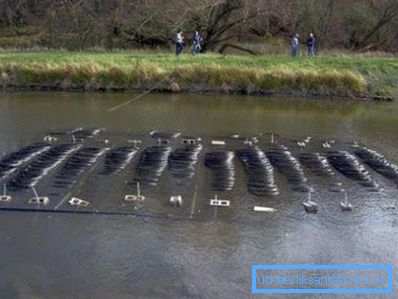
- For heat extraction, water is used from the well, which, after passing through the heat exchanger, drains into the second well.
The scheme is much cheaper than the first, but for obvious reasons, it is far from being applicable everywhere.
Air-to-air
All heat air pumps for heating are limited in operating temperature (usually down to -15 - -30C). At the same time, the COP of the device (the parameter describing the energy efficiency during heating. Indicates the ratio of the effective thermal and electric power) decreases with decreasing outdoor temperature.

However, for a warm climate zone, heating with an air heat pump more than pays for itself. With the cost of household appliances from 25,000 rubles with a thermal power of 3 kW, they simply cannot find alternatives.
Actually, the author will willingly share his own experience: the attic of his house is heated for the second year by a Cooper domestic air heat pump.&HunterCH-S12FTXN.
| Parameter | Value |
| Operating temperature range | Cooling +10 - +43 С, heating -25 - +20 |
| Energy efficiency | Cooling - 4.0, heating 4.2 |
| Average power consumption | Cooling 0.9 KW, heating 0.99 KW |
| Thermal power | Cooling 3.6 kW, heating 4.12 kW |
| Heated area (real) | 60 m2 |
| The room temperature at -15C outside | +22C |
| Additional functions | Plasma filter (odor and dust removal) |
The cost of heating two floors by air heat pumps amounted to approximately 2,500 rubles per month.
Of course, it is worth considering a couple of nuances:
- Place actions - Crimea, Sevastopol. Winter frosts are the exception rather than the rule. The average January temperature is +3 C.
- Electricity tariffs are currently slightly below average in Russia.
Conclusion
We hope that the information available to the reader will help him in the selection and design of heating. Additional materials about what could be the air heating of the cottage, will offer the attached video. Successes!